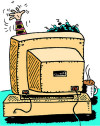Brandy redux
Posts: 2376
Joined: 2/7/2007
Status: offline

|
Following are the recommended procedures to follow when colors print incorrectly from any program.
Check the ink cartridges
Check the ink cartridges to make sure that one or more of the ink cartridges isn't running low.
This is a very important step - because many printed colors are created by taking ink from more than one ink cartridge. And, if one ink cartridge does not contain enough ink to be taken for a specific color, that color will not print correctly.
Update the printer driver
Go to the printer manufacturer's web site to download and install the correct and most current version of the printer driver for your Operating System.
NOTE: The printer driver which is installed on your computer should be the most current driver for both your Operating System and the version of that Operating System - either 32-bit or 64-bit. If you do not know which Operating System you are using, or which version you are using, go to Control Panel, select System, then look for the name of the Operating System (i.e. Windows XP, Windows Vista, Windows 7, etc.). Then, look for something which says either '32-bit Operating System' or '64-bit Operating System'. If you don't find any mention of either 32-bit or 64-bit, that would indicate that your Operating System is a 32-bit Operating System.
And, it is very important to keep in mind that the printer driver that is on the CD which is bundled with the printer is not always the most current printer driver. So, it's always a good idea to visit the printer manufacturer's web site on a regular basis to check for newer drivers.
Perform a Disk Cleanup
1. Go to 'My Computer' ('Computer' for Vista & Windows 7)
2. Right click on the C:\ drive, then select 'Properties' in the menu that drops down.
3. When the 'Properties' window opens, click on the 'Disk Cleanup' button, then follow through with the Disk Cleanup process.
NOTE: When the Disk Cleanup window opens (with the list of items to be deleted), make sure that there are checkmarks next to 'Temporary Internet Files', 'Recycle Bin' and 'Temporary Files' before you click on OK.
Delete Personal Temp files
1. Click on 'Start', then click on 'Run'.
2. Type %temp% in the box, then click on OK.
3. When the list of temp files is displayed, hold down the CTRL key while pressing the A key (to select all Files), then, hold down the CTRL key while pressing the D key (to delete all selected Files). If a window pops up during the deletion process telling you that the process cannot be completed, click on the 'Skip' button to move on to the next file. DO NOT click on either the 'Try Again' button or the 'Cancel' button.
One quick way to do this with Vista & Windows 7 would be to do this:
1. Click on 'Start'.
2. Type %temp%
3. When the temp item appears in the search window, click on that item.
4. When the list of files appears, hold down the CTRL key while pressing the A key (to select all Files), then, hold down the CTRL key while pressing the D key (to delete all selected Files).
< Message edited by Brandy redux -- 12/10/2010 11:59:00 AM >
_____________________________
For More Help: Click on the FAQ link at the top of this page Then, click on the All FAQ's button on the next page To contact me by email, please send your message to pine_97@yahoo.com
|

 Printable Version
Printable Version





 New Messages
New Messages No New Messages
No New Messages Hot Topic w/ New Messages
Hot Topic w/ New Messages Hot Topic w/o New Messages
Hot Topic w/o New Messages Locked w/ New Messages
Locked w/ New Messages Locked w/o New Messages
Locked w/o New Messages Post New Thread
Post New Thread